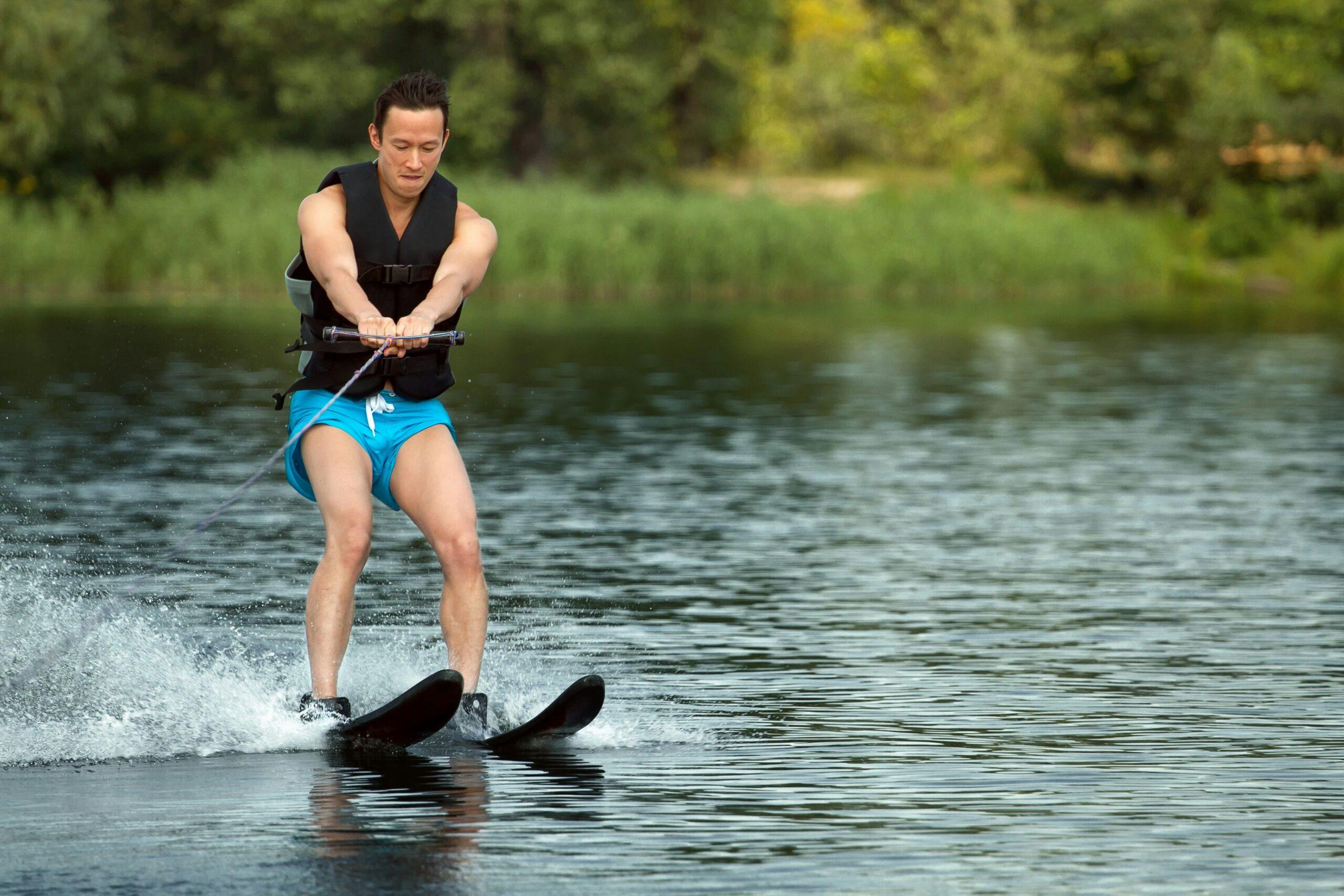Introduction:-Water skiing is a thrilling water sport that combines elements of speed, skill, and precision. Whether you’re a seasoned water skier or a beginner eager to hit the waves, understanding the rules and regulations is crucial for a safe and enjoyable experience. In this comprehensive guide, we’ll delve into the world of water skiing, exploring the rules that govern the sport, emphasizing safety measures, and providing insights for both beginners and experienced enthusiasts.
I. History of Water Skiing
Before we dive into the rules, let’s take a moment to appreciate the rich history of water skiing. The sport emerged in the early 1920s when Ralph Samuelson, an adventurous young man from Minnesota, attached wooden boards to his feet and used a clothesline as a tow rope to glide across the water. This pioneering act laid the foundation for modern water skiing, which has since evolved into a globally popular recreational and competitive activity.
II. Governing Bodies
Water skiing, like many sports, operates under the governance of international and national organizations. The two primary governing bodies for water skiing are the International Waterski & Wakeboard Federation (IWWF) and national water skiing federations in various countries. These organizations establish and enforce the rules to ensure fair play, safety, and standardization of the sport worldwide.
Discover the art of windsurfing with our exhilarating sports packages Bodybuilding and Bog snorkelling. Ride the wind, master the waves, and create memories that last a lifetime.
III. Basic Water Skiing Equipment
Before we delve into the rules, it’s essential to understand the basic equipment used in water skiing. The primary components include:
-
Water Skis: Typically made of fiberglass or composite materials, water skis are designed to provide buoyancy and stability. Skis come in various styles, such as slalom skis for single skiing and pair skis for two skiers.
-
Bindings: Securely attaching the skier’s feet to the skis, bindings come in different styles, including open-toe and closed-toe designs. Properly fitted bindings are crucial for safety and control.
-
Tow Rope: The tow rope connects the boat to the skier and is an essential element for water skiing. The length of the rope can vary, with longer ropes suitable for beginners and shorter ones for advanced skiers.
-
Life Jacket: Safety is paramount in water skiing, and wearing a Coast Guard-approved life jacket is mandatory. The jacket provides buoyancy and ensures the skier remains afloat in case of a fall.
IV. General Rules of Water Skiing
-
Boat Speed: The speed at which the boat travels is a critical factor in water skiing. The boat driver should adhere to recommended speed limits, which vary depending on the skier’s skill level and the type of skiing (slalom, trick, or jump).
-
Signal System: Communication between the skier and the boat driver is crucial. Standard hand signals are used to convey messages between the two parties, including speeding up, slowing down, or stopping.
-
Start and Finish: The water ski ride begins with the skier in the water, holding the tow rope handle. The boat gradually accelerates, allowing the skier to rise to the surface and start skiing. The ride concludes when the skier releases the tow rope or falls.
-
Right of Way: When multiple skiers are on the water simultaneously, those closer to the center of the course have the right of way. It is the responsibility of other skiers to yield and avoid interference.
V. Specific Water Skiing Disciplines
Water skiing encompasses various disciplines, each with its own set of rules and unique challenges. Let’s explore the rules governing the three main disciplines: slalom, trick skiing, and jump.
-
Slalom Skiing:
-
Course Design: A slalom course consists of a series of buoys arranged in a straight line. Skiers navigate through the course, rounding each buoy in succession.
-
Buoy Counts: In competitive slalom skiing, skiers start with a specific number of buoys to clear, and the difficulty increases as the line length shortens with each successful pass.
-
Fall Rules: If a skier falls during a pass, they have the option to repeat the pass at the same line length. Falling twice results in the end of their turn, and the boat returns to the dock.
-
-
Trick Skiing:
-
Trick Pass: In trick skiing, competitors have a set amount of time to perform a series of tricks, showcasing their skill and creativity. Each trick is assigned a point value.
-
Difficulty Levels: Tricks are categorized into different difficulty levels, and skiers are required to perform a certain number of tricks from each category. Judges evaluate the execution and assign scores accordingly.
-
Fall Rules: Similar to slalom skiing, competitors have the option to repeat a trick pass if they fall during their allotted time. Falls incur a point deduction.
-
-
Jump Skiing:
-
Ramp Setup: Jump skiing involves launching off a specially designed ramp. The height of the ramp and the distance jumped are crucial factors. Competitors aim to achieve maximum distance while executing stylish jumps.
-
Speed Control: The boat’s speed is critical in jump skiing. Skiers work with the boat driver to achieve the optimal speed for their jump, ensuring a safe and successful landing.
-
Fall Rules: If a skier falls during the jump, the distance achieved up to that point is recorded. Competitors have multiple attempts to achieve their best jump distance.
-
VI. Safety Measures
While the excitement of water skiing is undeniable, safety should always be the top priority. Here are essential safety measures for water skiing:
-
Life Jackets: Every participant, regardless of skill level, must wear a properly fitted and Coast Guard-approved life jacket.
-
Observer on Board: In addition to the boat driver, there should be an observer on board to keep an eye on the skier and communicate with the driver.
-
Swim Zone Awareness: Water skiing should only take place in designated areas, away from swim zones and other water activities.
-
Equipment Checks: Before each session, skiers should inspect their equipment, including skis, bindings, tow rope, and life jacket, to ensure everything is in good condition.
-
Communication: Clear communication between the skier, boat driver, and observer is crucial. Everyone should be aware of hand signals and follow proper communication protocols.
-
Weather Conditions: Water skiing is best enjoyed in favorable weather conditions. Avoid skiing in strong winds, storms, or low visibility.
VII. Competitive Water Skiing
Competitive water skiing brings together athletes from around the world to showcase their skills and vie for top honors. International tournaments, such as the IWWF World Water Ski Championships, feature elite athletes competing in slalom, trick skiing, and jump disciplines.
-
Qualification and Entry:
-
Athletes qualify for international competitions through national championships or selection trials.
-
Competitors must meet eligibility criteria set by the organizing bodies.
-
-
Scoring System:
- Each discipline has a specific scoring system. In slalom, the number of buoys cleared at each line length contributes to the overall score. Trick skiing and jump scores are based on point values assigned to each trick or the distance jumped.
-
World Records:
- The IWWF recognizes world records in each discipline. These records represent the highest achievements in water skiing and are continually challenged and surpassed by exceptional athletes.
-
Sportsmanship:
- Competitive water skiing emphasizes sportsmanship and fair play. Athletes are expected to compete with integrity and respect for their fellow competitors.
Conclusion
Water skiing is a dynamic and exhilarating sport that offers a unique blend of skill, speed, and precision. Whether you’re a beginner hitting the waves for the first time or a seasoned competitor aiming for new heights, understanding the rules and regulations is essential for a safe and enjoyable experience.
As you embark on your water skiing journey, always prioritize safety, adhere to the rules, and embrace the thrill of gliding across the water’s surface. With a foundation of knowledge and a commitment to excellence, you’ll find water skiing to be a truly rewarding and unforgettable aquatic adventure.



